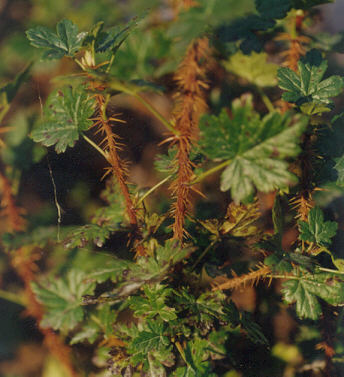Plant Data
Sheet: Black gooseberry/ swamp currant (Ribes lacustre)

Range
Black gooseberry occurs throughout Canada from Newfoundland to the Yukon Territory and in Alaska. It extends south into the continental United States in the Coast and Cascade ranges to northern California, in the Rocky Mountains to central Colorado and northern Utah, in the Great Lake States, and in the Appalachian Mountains. Black gooseberry also occurs in the Black Hills of the Great Plains region (1).
Climate,
elevation
Black gooseberry is found in cool, moist climates. It occurs from 7,700 to 10,500 feet in Utah, 7,000 to 11,400 feet in Colorado, 5,500 to 10,700 feet in Wyoming, and 3,000 to 8,700 feet in Montana. At the southern extremes of its range (California, Utah, Colorado, and West Virginia), black gooseberry occurs in cool, high-elevation forests (1).
Local
occurrence (where, how common)
In our area, black gooseberry is widespread and common.
Habitat
preferences
Black gooseberry prefers moist woods and streambanks to
drier forest slopes and ridges. It is
often found on rotting wood (1,4).
Plant
strategy type/successional stage
Black gooseberry is moderately shade tolerant, but grows vigorously in canopy openings. It establishes in partial shade or full sun after disturbance and then persists in the understory of closed canopy forests. Seedlings are suppressed on sites with more than 75 percent full shade (1).
Associated
species
Due to its wide range, black gooseberry is found with many species. Some examples in our region include western red cedar, western hemlock, devil's club, leafy moss (Mnium spp.), oak fern (Gymnocarpium dryopteris), Schreber's moss (Pleurozium schreberi), common ladyfern (Athyrium filix-femina), and horsetail (Equisetum spp.). In clearcuts in the Olympic Mountains, it is often found with oceanspray (Holodiscus discolor), thimbleberry (Rubus parviflorus), and common snowberry (Symphoricarpos albus) (1).
May
be collected as: (seed, layered, divisions, etc.)
Black
gooseberry can be propagated by seed or vegetative cuttings.
Collection
restrictions or guidelines
Vegetative
cuttings should be collected in the fall.
Collect seed promptly when the fruit ripens in autumn to prevent
bird herbivory. The fruit should be
macerated, and the seed extracted and dried (3).
Seed
germination
Seed is best sown in a cold frame
as soon as it ripens in the autumn. If stored, the seed requires four to six
months of cold stratification at about 0°C for 120-200 (2,3). It should then be planted early in the spring. Germination is best when the seed is sown
less than 1 cm deep in moist soil. Place seedlings in
individual pots when they are large enough to handle and grow them in a cold
frame for their first winter. They can be potted up or installed in the late
spring of the following year (3).
Seed
life (can be stored, short shelf-life, long shelf-life)
Under normal storage conditions
the seed can remain viable for 17 years or more (3).
Recommended
seed storage conditions
Most Ribes species store
well when sealed in a container with a low moisture content. Variable temperatures do not appear to
significantly affect viability (2).
Vegetative Propagation
Cuttings of half-ripe wood can be collected in July or
August and should be 15-20 cm long and with a heel. They should be planted
immediately in well drained soil. One or two buds should be exposed. Cuttings of mature wood of the
current year's growth, preferably with a heel of the previous year's growth,
can be collected from November to February and placed in a cold frame or
sheltered bed outdoors (3).
Propagation
recommendations
Propagation
by seed and cuttings are both widely recommended.
Soil
or medium requirements (inoculum necessary?)
Black
gooseberry is easily grown in moist but well-drained loamy soil (3).
Installation
form
Plants
can be installed as contained plants at a year or two old. Direct seeding is not recommended.
Recommended
planting density
Shrubs
should be planted three to five feet on center depending on desired density and
anticipated mortality (5).
Normal
rate of growth or spread; lifespan
Mature
height is typically 1.5-2 meters (1).
Sources
cited
(1) Carey, J. H.
(1995). Ribes lacustre. Fire Effects Information. United States Forest Service, United States
Department of Agriculture. http://www.fs.fed.us/
database/feis/index.html. Retrieved May 21, 2003.
(2) Pfister, R. Ribes L. Currant, gooseberry. Woody Plant Seed Manual. United States Forest Service, United States
Department of Agriculture. http://wpsm.net. Retrieved May 18, 2003.
(3) Plants for a Future. Ribes lacustre. http://plants.gardenbed.com/57/5633_cul.asp. Retrieved May 18, 2003.
(4) Pojar, J.
& MacKinnon, A (eds.) (1994). Plants of the Pacific Northwest Coast.
Vancouver, BC: Lone Pine.
(5) Sound Native Plants. http://www.soundnativeplants.com.
Retrieved May 18, 2003.
Data
compiled by (student name and date)
Sarah Baker
May 21, 2003